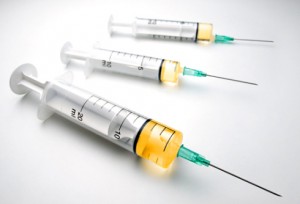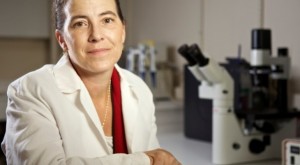This is the final part of a series; you can read Part 1 here , Part 2 here, Part 3 here and part 4 here.
In Cecile Richards’ dismal interview with ABC News Sunday, she portrayed disgust at pro-lifers who wanted to stop their research. Because of aborted babies, she said, with other words, researchers may develop an Ebola vaccine. “It’s laudable!” she insisted.
But Vicki Evans, who wrote her 2009 graduate thesis on the fetal research industry, with a dedicated chapter to the pharmaceutical aspect, says:
Cecile Richards presents a false dichotomy when she suggests that cures for Parkinson’s, Alzheimer’s and even Ebola vaccines are dependent on “laudable” donations of fetal tissue from elective abortion.

(via elnuevodespertar.wordpress.com)
Unfortunately, as Evans writes, “the commercial use of fetal tissue has revolved around the production of vaccines. Several commonly-used vaccines are cultured on human diploid fibroblast cell strains derived from electively-aborted human fetuses .”
And this was made possible by the same entity that made abortion possible in the first place: The Supreme Court.
Evans says in her thesis:
On June 16, 1980, in a reversal of decades of prior law, the Supreme Court ruled against the U.S. Patent Office in Diamond, Commissioner of Patents and Trademarks v. Chakrabarty. (42)
Evans discusses Peterson’s explanation of this case:
“The Supreme Court unleashed a deluge of industrial science by allowing the first patent to be placed on a living organism… Patents are vital to industry. The Supreme Court ruling reversed that of the U.S. Patent Office, which had long held that living things could not be patented. The decision opened the door to the patenting of genes, cell lines, tissues and organs. Human parts became products. Medicine became a golden business opportunity… [and]put dollar signs into the eyes of college administrators and their faculties. Universities began to see their medical laboratories as profit centers and their professors as entrepreneurs.” (M. Peterson, Our Daily Meds, Sarah Crichton Books, New York 2008, 178-179.)
Evans continues by explaining, “One of the practical results of these developments was to transform non-profit medical schools and teaching hospitals into entrepreneurial institutions with a financial stake in the studies they were carrying out, creating a pro-industry bias in medical research.”
Currently, society has seen some of what most deem a social good as a result of this, the most notable being vaccines for childhood disease. Evans says now:
There are about a half dozen fetal cell lines actively used in the pharmaceutical industry today and these were harvested from fetuses aborted in the 1960’s through the 1980’s. The further away you get from the historical abortion and the vaccine’s production, the more moral culpability decreases.
 The two most commonly known aborted fetal cells are WI-38 and MRC-5, which were used in the development of vaccines for chickenpox, the MMR (measles, mumps, rubella), smallpox, rabies, polio, DTaP, rheumatoid arthritis, shingles, and Hepatitis A and B, among others. The pro-life organization Children of God for Life maintains this list of vaccines and their sources, as well as when alternative ethical vaccines are available. Many hope the Planned Parenthood video scandal will also pave the way for more ethical vaccine research that doesn’t use aborted fetal cells. Evans offers her take:
The two most commonly known aborted fetal cells are WI-38 and MRC-5, which were used in the development of vaccines for chickenpox, the MMR (measles, mumps, rubella), smallpox, rabies, polio, DTaP, rheumatoid arthritis, shingles, and Hepatitis A and B, among others. The pro-life organization Children of God for Life maintains this list of vaccines and their sources, as well as when alternative ethical vaccines are available. Many hope the Planned Parenthood video scandal will also pave the way for more ethical vaccine research that doesn’t use aborted fetal cells. Evans offers her take:
A vaccine’s origin in aborted fetal tissue does render it illicit and there is a serious obligation to use alternative vaccines, if they exist, and to conscientiously object to those that are tainted. There is also a moral duty to employ every lawful means to change unethical actions in the production of these vaccines.
Since we cannot change the past, it is necessary to look to the future to develop ethical alternatives. Scientists have affirmed that these alternatives do exist (the use of recombinant DNA technology, for example). Whether they will be pursued depends on stopping the easy and profitable flow of aborted fetal tissue and encouraging research in other directions.
Many of these vaccines do have ethical alternatives, but as one mom discovered, they may have to be demanded from a doctor, and insurance may not cover them. She said then, “If they wanted my child vaccinated that badly, they’d get me the alternative vaccinations.” And they did. She had to pay for the alternative vaccines, but considered her son worth the extra cost. However, many people don’t even know these options exist.
But as Evans notes, there are some vaccines that don’t have any ethical alternatives, and those are generally the important ones such as MMR. She writes:
But how long will it take for drug companies to stop paying to license another’s cell-line technology in favor of developing their own? Cell lines are not immortal, as was once believed, and more will be needed to keep pace with scientific and technological discoveries. The door is open to development of additional human diploid cell strains, which will require more fetal tissue. (49)

Dr. Theresa Deisher
Dr. Theresa Deisher (pictured right), who leads Sound Choice Pharmaceutical Institute, has committed her career to ethical vaccine development, so that, ultimately, every deadly disease can be vaccinated against without the further development of aborted fetal cell lines.
Evans’s comment on Richards creating a “false dichotomy” that insists Parkinson’s, Ebola or other diseases can only be cured by using dead babies is an important one, because the hope is that now that the truth about fetal research is emerging from darkness into light, researchers will begin to see the market for developing ethical vaccines, as well. It is actually possible to have both an Ebola vaccine and to abstain from using fetal cells to develop it. Perhaps that is Planned Parenthood’s greatest fear in all of this: realizing society does not need its services to thrive.
Evans continues her work against the tragedy of fetal parts sales and research. Working now as the Respect Life Coordinator for the San Francisco Archdiocesan Office of Public Policy & Social Concerns, she sounds the trumpet in every way she’s been given opportunity, bringing truth and believing for an end to the horror of the profit off the shedding of innocent blood which contaminates our land with guilt.







